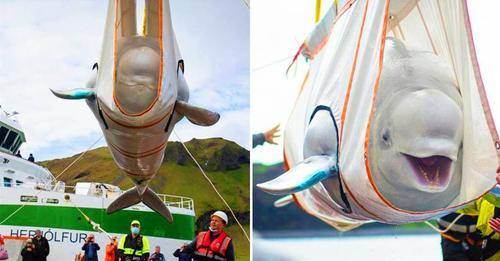
In the remote and icy wilderness of Antarctica, a team of researchers made a shocking discovery that has sent shockwaves through the scientific community. Behind a towering wall of ice, they unearthed the remains of a giant creature, shrouded in mystery and perplexity.
The team, comprised of seasoned explorers and scientists, had embarked on an expedition to study the effects of climate change on the polar region. Little did they know that their mission would lead them to the startling find of a lifetime.
As they drilled through the thick layers of ice, their instruments picked up anomalous readings that piqued their curiosity.
After hours of meticulous work, they finally broke through to the other side and were met with an astonishing sight. There, preserved in a state of near-perfect fossilization, lay the massive skeletal remains of a creature unlike anything they had ever seen.
The team immediately recognized the significance of their find and set about carefully documenting and analyzing the remains. What they uncovered defied all expectations and plunged them into a conundrum that has left the scientific community in a state of bewilderment.
The creature, which they have dubbed the "Antarctic Enigma," appeared to be a colossal bipedal being, standing at over 30 feet in height.
Its skeletal structure bore resemblance to that of a humanoid, yet its proportions were far beyond anything seen in the fossil record. The sheer magnitude of its size and the advanced state of preservation left the researchers struggling to comprehend the implications of their discovery.
Initial radiocarbon dating of the surrounding geological strata suggested that the creature lived during the late Pleistocene era, a time when megafauna roamed the Earth. However, the sheer size of the Antarctic Enigma far surpassed any known species from that period, raising perplexing questions about its origins and evolutionary history.
As news of the find spread, speculation and conjecture ran rife, with theories ranging from extraterrestrial origins to the existence of a lost civilization. The scientific community remained divided, with some dismissing the Antarctic Enigma as an elaborate hoax, while others clamored for further investigation and analysis.
The discovery also ignited a fierce debate about the ancient history of Antarctica, a continent long cloaked in enigma and speculation. While modern Antarctica is a desolate and frozen wasteland, there is mounting evidence to suggest that it was once teeming with life, a land of lush forests and diverse fauna.
The presence of such a colossal creature only added fuel to the fire, reigniting interest in the continent's mysterious past.
In an effort to unravel the enigma, the research team delved into a comprehensive study of the creature's anatomy and physiology. They meticulously cataloged every bone and fragment, using cutting-edge imaging techniques to reconstruct its form in minute detail. The resulting 3D renderings and computer simulations painted a staggering picture of the Antarctic Enigma's physical attributes, revealing a creature of immense power and resilience.
One of the most perplexing aspects of the Antarctic Enigma was its apparent adaptation to the harsh polar environment.
Analysis of its bone structure and musculature suggested that it was perfectly suited to withstand the extreme cold and physical demands of the region. This led to speculation about the creature's lifestyle and behavior, with some positing that it may have been an apex predator, ruling over the ancient Antarctic landscape.
As the research team delved deeper into their analysis, they made an even more astonishing discovery. Trapped within the layers of ice surrounding the Antarctic Enigma, they found traces of organic material that bore the unmistakable signature of ancient DNA. If confirmed, this would represent an unprecedented breakthrough, offering a tantalizing glimpse into the genetic makeup of a long-extinct species.
The implications of this finding were profound, opening up the possibility of resurrecting the Antarctic Enigma through advanced genetic engineering. The prospect of bringing a creature from the depths of prehistory back to life sent shockwaves through the scientific and ethical realms, raising profound questions about the consequences of playing with the fabric of life itself.
Meanwhile, the research team also embarked on a quest to uncover the creature's place in the broader context of Earth's history. They scoured the annals of paleontology and evolutionary biology, seeking any clues that might shed light on the Antarctic Enigma's origins.
Their efforts yielded tantalizing hints of a lost chapter in the saga of life on Earth, hinting at the existence of ancient megafauna that lay beyond the bounds of current understanding.
As the research unfolded, the expedition team found themselves embroiled in a race against time. The harsh Antarctic environment posed a relentless challenge, with treacherous weather and logistical hurdles threatening to derail their efforts. Yet, their determination and perseverance drove them forward, fueling a relentless pursuit of answers and revelation.
In the midst of their investigation, the team also faced fierce scrutiny and skepticism from the scientific community.
Some experts questioned the validity of their findings, demanding further evidence and corroboration. Others warned of the potential consequences of disrupting the delicate balance of Earth's ecology by meddling with the remains of such a colossal and enigmatic creature.
The Antarctic Enigma had unquestionably sparked a whirlwind of controversy and debate, punctuated by fervent speculation and fervor. Yet, amidst the cacophony of voices, there emerged a unified call for measured and rigorous scientific inquiry, a quest for verifiable truth over sensationalism and conjecture.
The research team heeded this call, redoubling their efforts to unravel the secrets of the Antarctic Enigma.
They embarked on a worldwide collaborative effort, enlisting the expertise of leading scientists and researchers from diverse disciplines. This interdisciplinary approach yielded a wealth of new insights and perspectives, opening up fresh avenues of inquiry and exploration.
Among the most promising developments was the discovery of a trove of ancient artifacts and relics in the vicinity of the Antarctic Enigma. These artifacts hinted at the existence of a sophisticated civilization that once thrived in the region, shrouded in the mists of antiquity. This revelation sparked a surge of excitement and speculation, igniting visions of a lost world waiting to be unveiled.
As the research team pieced together the puzzle of the Antarctic Enigma, they also grappled with profound ethical and moral considerations. The prospect of resurrecting a long-extinct species carried weighty implications, raising fundamental questions about humanity's role as custodians of life on Earth. The delicate balance between scientific curiosity and reverence for the mysteries of nature hung in the balance, demanding a cautious and thoughtful approach.
Ultimately, the Antarctic Enigma stands as a testament to the boundless enigma of the natural world, a reminder of the vast depths of time and space that lie beyond our comprehension.
Its discovery has ignited a fervent quest for knowledge and understanding, challenging the boundaries of human inquiry and instilling a sense of awe and wonder at the unfathomable mysteries that await us in the uncharted reaches of our planet. As the research team continues to delve deeper into the secrets of this ancient giant, they hold fast to the belief that the pursuit of truth and revelation will ultimately prevail, unraveling the enigma that has lain dormant in the icy heart of Antarctica for eons untold.




















